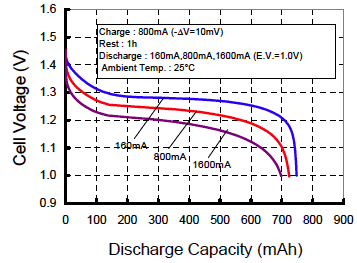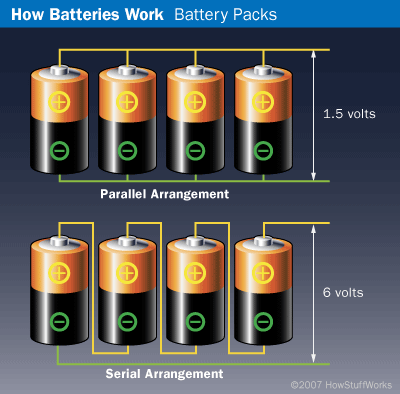
The standard size for a dry cell battery is AA or AAA, which is usually used for low drain electronic devices and gadgets. AAA batteries only measure 10.5 mm and used as a single cell.
What is the difference between the voltage of an AA and AAA battery? AA and AAA battery voltage has a nominal voltage of 1.5V. The energy of these batteries will generally decrease during the lifespan of a cell.
AAA and AA batteries are most commonly found in the household. It powers small electronic gadgets like flashlights, radio, and calculators. It caters to more people than other battery types.
What Are The Voltage Of AA & AAA Battery?
As I have already answered earlier, the voltage of both battery types is 1.5 nominal voltage.
What About The Voltage Of Lithium AA Batteries?
Lithium AA batteries have a 3V voltage, while the rechargeable lithium batteries have 3.5 Voltage. The NiMH and NiCd are both rechargeable batteries and have 3.5 and 1.2 Voltage.
What Voltages Indicates Bad For AA & AAA Battery?
A suitable voltage for an AA and Triple-A batteries is something in between 1.1V and 1.5V. That means the battery has a full charge. However, if the voltage drops to something below 1.1V is already a dead battery. You may use a voltmeter to test how much power is left in your alkaline batteries.
Here are some steps or procedures you can follow in testing your AA and AAA batteries below:
Step 1: Using your voltmeter or multimeter, you have to set it under the DC mode. You can find the DC mode in the center dial with the label VDC. Sometimes it is the single line with three dashed lines under it.
Step 2: The multimeter must be set to a voltage nearing the 1.5 Voltage, while it is placed under the DC mode. Usually, the dials of a multimeter have values increasing by 10s. For example, a multimeter will have a set of 2V, 20V, 30V … and 200V settings for the AC mode. And since AA and AAA batteries are only 1.5V, you have to choose 2V.
Step 3: Connect the multimeter’s red lead to the positive terminal of the battery. The elevated bump on an AA and Triple A batteries are the + terminal. The black lead of the multimeter to the negative terminal; this is the flat end of the cell.
Step 4: Hold both ends of the lead and read the multimeter display. The multimeter should have a reading of 1.1V to 1.5V to indicate a full charge and a reasonable charge. If your meter reading falls from 1.1V and below, that means that your battery does not have sufficient charge or maybe dead.
What Are The Voltage Of These Dead Battery?
We call a battery nearing depletion to be in its end-voltage. Every chemistry has its specific voltage, and 90% of the initial energy is often referred to as the end voltage.
By using the application, we can best specify the end voltage of a battery. Electronic appliance and gadgets have their particular energy in which it begins to fail or hinders itself from the proper operation. This reading would indicate the total no.of cells or the full voltage.
Portable equipment will often range from 1 to 1.1, but there are times when it will go down to 0.9V. When the digits continue to lower, it will make the equipment operate longer during the set of battery charge.
It is also the same reason why primary battery manufacturers don’t use Amp hours. They prefer to show the voltage discharge curves against time. Another reason is that the capacity differs by discharge rate. They also make a list of multiple curves through the current.
What Are The Differences Between AA And AAA Batteries?
Both AA and AAA batteries are called alkaline cells. They are both used to power electronic gadgets and devices. But, besides that what sets them apart?
1. AAA batteries are different in size with a AA battery. AAA batteries are much smaller than AA cells. The Energy Storing Capacity is relative to the size of the battery. Although they are both giving off 1.5V, the amount of energy to be wasted also varies. AA batteries tend to keep the power a little longer than AAA cells.
2. The difference in price also varies. The law of supply and demand dictates the future of cost differences.
3. In terms of sale, AA batteries are sold much more than AAA cells. There is more demand for AA batteries than AAA batteries. For every 12 purchases made for these batteries, 10 or 11 are AA batteries, while AAA batteries remained to be costly because there are low production and low demand.
What Are These Battery Nominal Voltage?
Nominal means name. For a battery like the AA and AAA, nominal voltage refers to the RMS value.
Nominal voltage refers to the system voltage during the distribution point, let’s say for example 220VAC. When we say Nominal utilization voltage, it is the energy consume at user point. It is also the one imprinted on the equipment, e.g., 120VAC.
Voltage ranges also refer to the defined highs and lows above the numbers that are needed to be maintained. Every system and supplies should be required to conform to that kind of limitations.
Ranges are the one that defines the limit within the nominal values.
AA & AAA Battery Voltage Chart

This chart shows the battery voltage rate against the its discharge capacity. Looking at the table or chart, you’ll see that a battery with a voltage of 1.5 has a discharge rate of 750mAh.
3 AA Battery Voltage Range
To better understand battery voltage range and capacity, you should try to understand this correlation between voltage and capacity. A cell stores up energy, while function refers to how much energy it can store. Does that make sense?
In a typical battery like the basic types, a constant voltage can be replaced with volts multiplied by the amps. Voltage is the normal parameters for a cell. Once you have chosen the energy, you can specify the capacity by the amp-hour rating.
An alkaline battery or NiMH cell in a standard AA size has something about 2000 to 3000 mAh. With a battery voltage of 1.2V up to 1.5V will correspond to 2 to 4 Wh with each battery. If you use multiple arrays in a series, the voltage rises but the capacity in the amp-hours will remain the same.
Therefore, if you will be using 3 AA battery in a series, it will give you higher voltage. If you arrange them in parallel, it will provide you with the same energy as a single cell.
4 AA Battery Voltage Range
4AA battery voltage range as we have explained in a 3AA battery depends on how you used them. The voltage rises if you arrange these batteries in a series. If they are in parallel, it increases the current flow.
How These Battery Arrangement And Power Works?
To further explain how a 3AA and 4AA voltage range works, it will be helpful to understand the battery arrangement and power.

Battery Arrangement
● Parallel Arrangement. Showing the diagram on top, it shows a parallel method of batteries. These four batteries in a parallel system will produce the same voltage as a single battery, 1.5V.
The rate in which an electric charge passes through a circuit is called a Current. We usually measure the current through Amperes. In general, batteries with a higher ampere per hour ratings are the ones with greater capacities.
● Serial Arrangement. The lower diagram shows an example of a serial arrangement. When you series four batteries it will produce the current of one battery. However, the voltage will be four times of a single cell. The measurement of energy per unit charge is what we call voltage, and it is measured in volts.
In a battery, voltage is the determinant on how strong the electrons are pushed into the circuits, in the same way, that pressure is the one that determines how strong the water will be pushed into the hose. Majority of the alkaline batteries like AA, Triple-A, C and D batteries have 1.5V.
To show you more clearly, the diagram showed batteries with a rate of 1.5V and 500 milliamps per hour. In a parallel arrangement, the four cells will produce 1.5V with a speed of 2000 milliamps-hour while the four batteries in a series will be able to provide 6V with 500 milliamps-hour.
How To Check AA And AAA Battery Voltage
Checking Battery voltage is easy if you have all the materials and tools you needed. You can check battery voltage by using a multimeter.
You will need the following:
● Voltmeter
● AA or AAA batteries
Things you need to know:
● AA/AAA Alkaline batteries have a voltage of 1.5V
● AA/AAA NiMH or NiCd rechargeable batteries have a voltage of 1.25V
Ways To Test AA & AAA Battery With Multimeter
Connect the voltmeter to your battery terminals and set to the DCV mode. Make sure that you set the voltage far from the energy of the batteries. If it has a 20V in DCV mode, set it there. Check the connections properly, positive terminal for positive cable and vice versa.
If the reading gives you more than 1.3V for non-rechargeable batteries, then it still has some juice in it, you can still use the batteries. If it is lower than 1.3V, then you can properly dispose of your cells.
It is really important to learn how batteries work. AA and AAA battery voltage helps us to know if the batteries we have at home will still work after storing it for several months. You might be storing these batteries not knowing they can self-discharge after several months.





